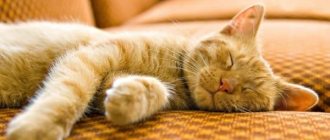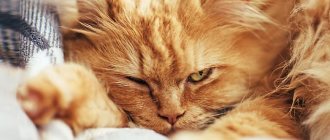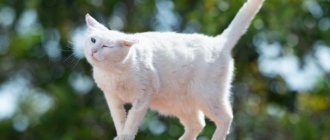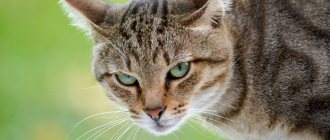Why does a cat shake with small tremors: reasons, what to do, when to contact a veterinarian
Owners of cats may encounter an unusual condition of the animal: the cat is trembling as if it is cold.
The owners see the reason that the pet is simply cold. But the frequent repetition of this phenomenon serves as a signal that pathological processes are developing in the animal’s body, the animal is experiencing severe stress, and has become infected with an infectious disease.
Unreasonable trembling should be a reason to contact a veterinary clinic to a specialist, where the doctor will identify the presence of disorders and prescribe treatment.
Cucumbers and cats
Many people are still interested in knowing why cats are afraid of cucumbers. Now let's try to understand this issue. Nowadays you can see many videos where the owner puts a cucumber next to the cat, and she gets scared of it. Why is this happening? Most likely, if a person gives the pet some other unknown object or vegetable, the reaction will be the same. The thing is that the animal simply did not expect to see a cucumber in this place. After all, the cat regards the place where it eats as safe. That's why she's calm and relaxed here. The appearance of a long, green, incomprehensible object at a very close distance is perceived as a threat. Also in appearance this vegetable resembles a snake. She is also the cat's worst enemy.
So, why are cats afraid of cucumbers? After analyzing the situation, zoologists came to the conclusion that such a reaction is natural for the animal. It’s just that cats are not used to cucumbers; they rarely come across them. If a green vegetable appears at the time of eating, that is, when the animal is completely relaxed, then this causes severe fear, which is manifested by a standard reaction - a sharp jump, flight or hissing.
The cat is shaking - the main reasons
Tremor (whole body trembling) is a rhythmic muscle contraction caused by internal or external factors, such as:
- change in temperature,
- reaction to stressful situations,
- sexual arousal,
- pathology.
- Cold, heat.
If the animal begins to tremble, having wet its skin, this behavior is normal. The furry predator is able to withstand low air temperatures, but does not tolerate humidity well.
The problem is especially urgent for a kitten; self-regulation of the body in babies is still weak, they are especially sensitive to humidity, but the development of seizures indicates a serious illness. Overheating of the body can lead to heatstroke, which in turn leads to tremors.
Attentive owners notice that the pet’s behavior when seeing unfamiliar people or things looks like this: the body begins to shake from small tremors. Fear of the unknown, especially fear, causes symptoms such as tremors of the limbs and involuntary urination.
Strong emotions (negative or positive) can cause involuntary muscle contractions. The cat is trembling not because of poor health, but from joy after a long separation from the owner, and so on.
An animal in heat often trembles when it sees an individual of the opposite sex. The hormonal surge that begins when looking at a potential partner leads to trembling. If trembling occurs in an animal after sterilization, you should have your pet checked by a veterinarian.
The cat trembles in his sleep as if he is freezing and cold
Owners of cats may encounter an unusual condition of the animal: the cat is trembling as if it is cold. The owners see the reason that the pet is simply cold.
But the frequent repetition of this phenomenon serves as a signal that pathological processes are developing in the animal’s body, the animal is experiencing severe stress, and has become infected with an infectious disease.
Unreasonable trembling should be a reason to contact a veterinary clinic to a specialist, where the doctor will identify the presence of disorders and prescribe treatment.
The cat is shaking - the main reasons
Tremor (whole body trembling) is a rhythmic muscle contraction caused by internal or external factors, such as:
- change in temperature,
- reaction to stressful situations,
- sexual arousal,
- pathology.
If the animal begins to tremble, having wet its skin, this behavior is normal. The furry predator is able to withstand low air temperatures, but does not tolerate humidity well.
The problem is especially urgent for a kitten; self-regulation of the body in babies is still weak, they are especially sensitive to humidity, but the development of seizures indicates a serious illness. Overheating of the body can lead to heatstroke, which in turn leads to tremors.
Attentive owners notice that the pet’s behavior when seeing unfamiliar people or things looks like this: the body begins to shake from small tremors. Fear of the unknown, especially fear, causes symptoms such as tremors of the limbs and involuntary urination.
Strong emotions (negative or positive) can cause involuntary muscle contractions. The cat is trembling not because of poor health, but from joy after a long separation from the owner, and so on.
An animal in heat often trembles when it sees an individual of the opposite sex. The hormonal surge that begins when looking at a potential partner leads to trembling. If trembling occurs in an animal after sterilization, you should have your pet checked by a veterinarian.
When to contact a veterinarian
If your cat often trembles and there are additional signs of ill health (increased aggression, lethargy, frequent bowel movements, vomiting, constipation), you should immediately visit a veterinary clinic.
- Tremor can be one of the symptoms when affected by toxic substances. The poison in the cat’s body is absorbed gradually, slight trembling is replaced by convulsions.
- Minor trembling coupled with lethargy may indicate the development of an infection.
- Infection with worms is accompanied by constipation or diarrhea, perversion of taste, and chills.
- Shaking of the entire body and head may indicate internal injuries.
- A tick bite may also be accompanied by trembling.
- Chills, accompanied by coughing, sneezing, and discharge from the sinuses, indicate damage to the bronchi and pneumonia.
- Damage to the meninges as a result of the development of meningitis, tick-borne encephalitis, borreliosis, rabies, is often accompanied by severe trembling and convulsions.
What to do if your cat is shaking
If an animal exhibits involuntary trembling, the owner should:
- analyze previous events,
- exclude external factors (hypothermia, overheating, fear, sexual overstimulation),
- contact a veterinarian to diagnose the disease and begin treatment in time.
Do you know what to do if your pet is shaking due to external reasons?
- In case of hypothermia, warm the animal, dry the skin, and massage the body.
- In case of overheating, cool the body with cool compresses and inject water into the oral cavity from a syringe without a needle.
- In case of stress, calm the pet down and protect it from objects that cause fear.
- During sexual hunting, you need to carefully monitor the pet’s condition and give medications that reduce attraction to the opposite sex.
Conclusion
Cats are distinguished by excellent health, the animal’s body is adapted to the cold; if a furry predator begins to tremble, this fact should not be ignored. The owner is obliged to find out the causes of the problem and eliminate the consequences as quickly as possible.
Why is the kitten shaking as if he is cold?
Many owners of four-legged pets are interested in the question of why the kitten is trembling and how dangerous it is for its health. Tremor (involuntary muscle contraction) can occur from both pathological and physiological primary sources, which can be determined by secondary symptoms or the results of a diagnostic examination.
Reasons why a cat may tremble
Non-pathological underlying causes of strange muscle contractions are not dangerous and can be easily prevented by eliminating predisposing factors.
Joy and positive emotions
There are several reasons why a cat trembles:
- reaction to a favorite treat;
- excitement during games;
- interest in birds or insects seen through the window;
- joy at the sight of the owner or a new toy.
Domestic cat
In these cases, the deviation is temporary and goes away on its own after a short period.
The blanket is in the way
Some pets hate any foreign things placed on them.
Cat in a blanket
Foreign blankets include blankets that are put on after surgery. By contracting muscles, the cat tries to get rid of discomfort.
The cat is frozen
Comfortable temperature conditions for furry pets include the following indicators:
- for newborn babies - 31 degrees and above;
- for older kittens - 24 degrees.
Wide open windows, lack of heating, and drafts cause the cat to tremble, trying to warm up. Secondary symptoms of hypothermia include drowsiness, apathy, decreased heart rate, breathing and temperature.
Fatigue after exercise
Prolonged physical activity, chasing a butterfly or a bird leads to a problem. The deviation resembles the reaction of the human body to excessive physical activity: voluntary contractions of the leg muscles after running. After rest, the symptoms disappear.
The animal got scared
If a cat is shaking with small tremors, she meows continuously, tries to hide in a secluded place, behind the sofa, and the hair on the back of her neck stands on end, then she is simply scared.
Fear is provoked both by the arrival of strangers and by a working vacuum cleaner or mixer.
Puberty of a cat
Why does a cat shake after 5 months: one of the root causes includes growing up and puberty. In young animals, the unusual condition causes unreasonable fear and stress.
Trembling as a warning sign
The pathological appearance of tremors is associated with a variety of diseases. Without diagnosis, it is difficult to determine the original source - many pathologies have similar symptoms.
Trembling croup and generalized tremor
Muscle contractions are the consequences of damage to the spinal column, deformation changes in its structure, stenosis in the spinal canal, malignant or benign neoplasms.
Inflammatory process
The penetration of pathogenic microflora provokes inflammation and febrile syndrome. Most often, the phenomenon occurs in the postoperative period and manifests itself:
- swelling of the suture;
- suppuration and release of ichor from the wound;
- vomiting, refusal to eat;
- pet's indifference.
Calcivirus infection
A healthy cat may shiver as if it were cold with a latent form of the disease. When the disease becomes chronic, it leads to the appearance of a characteristic clinical picture:
- discharge from the nasal passages and organs of vision;
- intermittent claudication, lethargy, apathy;
- Immunity impairment provokes relapse and transition to the acute phase of the pathology.
Central nervous system disorders
Why do cats tremble when the central nervous system is damaged: the source may be epilepsy, meningitis or encephalitis. Common symptoms of these diseases include:
- rapid breathing and increased heart rate;
- bouts of vomiting;
- strong secretion of saliva;
- convulsions, unsteadiness of gait;
- feverish syndrome, anxiety.
Salivation
Subclinical form of panleukopenia
The course of the pathological process leads to the occurrence of clinical manifestations:
- lethargy, increased temperature;
- refusal to eat and drink - against the background of constant thirst;
- attacks of vomiting;
- increased gas formation and diarrhea.
The latent course lasts 10 days, after which it becomes clear why the kitten is shaking involuntarily.
Hidden period of rhinotracheitis
Incubation time takes about 7 days, the primary symptoms of the pathology are characterized by:
- loss of appetite, apathy;
- discharge from the nasal passages and eyes - later the contents become purulent-mucosal;
- ulcerations form on the tongue, and a parenchymal form of keratitis forms.
Lack of vitamins
The kitten may tremble due to a deficiency of nutrients. Insufficient intake of B vitamins causes symptomatic manifestations:
- muscle contraction, lethargy;
- growth slowdown;
- dulling of fur;
- peeling of the skin.
Metabolic disorders
Problems with metabolism lead to the development of:
- eclampsia - convulsive syndrome occurs during or after childbirth and varies in intensity;
- hypoglycemia - a reduced amount of glucose in the bloodstream causes convulsive muscle contractions, a semi-fainting state, and the cat tries to sleep non-stop.
Why does a cat shake after sterilization?
Initially, the pet will have problems with coordination of movements and involuntary muscle contractions. The deviation refers to a normal reaction to drugs administered during surgery; after a few hours it disappears spontaneously.
Sterilization
The owner needs to monitor the animal’s condition throughout the recovery period after sterilization - if the pet continues to shudder, fainting and vomiting, then a consultation with a veterinarian is necessary.
The process of recovery from anesthesia
Symptoms that occur after surgery include:
- constant attempts to fall asleep in any position;
- lack of coordination; when trying to stand up, the pet twitches and falls on its side;
- hard breath;
- searching for a dark place;
- involuntary release of urine and feces;
- salivation.
The pupil is dilated, without reaction to light, the anomaly is present for 1-2 days. The animal fully recovers after anesthesia within 2-3 days.
Symptomatic treatment
Therapeutic methods for physiological sources of the problem:
- hypothermia - the animal is warmed up, a light massage is performed, and the wet fur is dried with a towel after washing;
- overheating - cooling with compresses, the cat is allowed to drink on demand;
- stress - removing the source of fear, creating peace and quiet;
- sexual arousal is suppressed with special drugs.
Treatment of the pathological origin of muscle tremors is carried out with antibacterial agents, replenishment of vitamin and mineral deficiencies, and operations to remove tumors.
Furry pets are in excellent health; if the cat begins to shake with small tremors, then you need to undergo a diagnostic examination and find out the original source of the abnormal condition. Ignoring the problem can lead to the development of unpredictable consequences for the health of the animal.
Source: https://slavarod.ru/voprosy/kot-drozhit-vo-sne-kak-budto-myorznet-i-emu-holodno
When cats can shake
Cats can tremble not only in their sleep, but also while awake. The main problem for the owner is determining the cause of the trembling and whether any disease is present.
If this phenomenon occurs quite often, it is necessary to determine the room temperature. If the room temperature is not comfortable for the pet, measures should be taken to provide warmth to the pet. The measure consists of raising the room temperature or providing the animal with warm bedding and eliminating drafts.
It is necessary to provide cats with warm bedding.
Sign that the cat is freezing
A sign that your pet is freezing can be the “curl” position adopted during sleep and a deeply hidden nose.
The cat hides its nose if it is cold.
Factors
- Another possible factor for tremors in a cat may be uncomfortable posture . Cat muscles and joints are capable of reacting this way to being in an uncomfortable position for a long time.
- An equally significant fact can be stress or previously experienced fear . A possible reason is the animal’s excessive activity during hunting and games. As well as the presence of injury or bruise.
The fact that a cat is trembling may be due to stress.
Pathologies
It is necessary to diagnose the pathology in time.
Tremor can accompany the development of pathologies, so owners should closely monitor their pet and seek advice from a specialist.
Possible pathologies:
It is necessary to diagnose a possible pathology in time and take all measures to eliminate it.
Associated symptoms
The red cat is trembling, why?
Let's take a closer look.
conclusions
In order not to miss the onset of the development of the disease, you should carefully observe the pet’s behavior while awake. Get vaccinated on time and undergo medical examination.
about a cat who twitches in his sleep
Source: https://mykoshka.ru/kot-drozhit-kogda-lezhit-kak-budto-emu-xolodno/
When to contact a veterinarian
If your cat often trembles and there are additional signs of ill health (increased aggression, lethargy, frequent bowel movements, vomiting, constipation), you should immediately visit a veterinary clinic.
- Tremor can be one of the symptoms when affected by toxic substances. The poison in the cat’s body is absorbed gradually, slight trembling is replaced by convulsions.
- Minor trembling coupled with lethargy may indicate the development of an infection.
- Infection with worms is accompanied by constipation or diarrhea, perversion of taste, and chills.
- Shaking of the entire body and head may indicate internal injuries.
- A tick bite may also be accompanied by trembling.
- Chills, accompanied by coughing, sneezing, and discharge from the sinuses, indicate damage to the bronchi and pneumonia.
- Damage to the meninges as a result of the development of meningitis, tick-borne encephalitis, borreliosis, rabies, is often accompanied by severe trembling and convulsions.
What causes seizures?
A cat twitches convulsively in its sleep due to the presence of an internal disease or a pathological process caused by parasites. The most common causes of seizures are:
- tumors;
- lymph inflammation;
- brain diseases;
- mental pathologies;
- deficiency of calcium or other substances;
- disturbances in the functions of the peripheral nervous system;
- infection by parasites and others.
When figuring out why cats twitch in their sleep, doctors identify specific diseases, including:
- non-purulent meningoencephalitis;
- cerebral ischemic encephalopathy;
- viral infectious peritonitis;
- toxoplasmosis;
- hyperparathyroidism;
- helminthiasis;
- ticks and fleas;
- excess medications or other drugs and additives in the blood;
- microstroke;
- lack of vitamin B;
- urolithiasis disease;
- renal failure;
- anemia.
Each of these diseases is very serious, but the most dangerous of them are meningoencephalitis, encephalopia and peritonitis.
What to do if your cat is shaking
If an animal exhibits involuntary trembling, the owner should:
- analyze previous events,
- exclude external factors (hypothermia, overheating, fear, sexual overstimulation),
- contact a veterinarian to diagnose the disease and begin treatment in time.
Do you know what to do if your pet is shaking due to external reasons?
- In case of hypothermia, warm the animal, dry the skin, and massage the body.
- In case of overheating, cool the body with cool compresses and inject water into the oral cavity from a syringe without a needle.
- In case of stress, calm the pet down and protect it from objects that cause fear.
- During sexual hunting, you need to carefully monitor the pet’s condition and give medications that reduce attraction to the opposite sex.
More serious reasons
Thinking about why a cat is trembling, I would like to talk about more serious reasons for this phenomenon. Trembling may be a symptom of kidney disease. If there is a possibility or predisposition of your animal to such a disease, then you should definitely visit a veterinarian and conduct the necessary examination.
Also, trembling in the limbs can be a concomitant symptom of a disease such as rhinotracheitis. But if it is a viral infection, then the animal will also experience: nasal discharge, high fever, hoarseness and possible vomiting.
If then her body may tremble slightly. Symptoms of this disease also include: apathy, “glassy” eyes, increased salivation. The cat must be treated, otherwise paralysis may occur.
Reasons why a cat may tremble
Non-pathological underlying causes of strange muscle contractions are not dangerous and can be easily prevented by eliminating predisposing factors.
Joy and positive emotions
There are several reasons why a cat trembles:
- reaction to a favorite treat;
- excitement during games;
- interest in birds or insects seen through the window;
- joy at the sight of the owner or a new toy.
Domestic cat
In these cases, the deviation is temporary and goes away on its own after a short period.
The blanket is in the way
Some pets hate any foreign things placed on them.
Cat in a blanket
Foreign blankets include blankets that are put on after surgery. By contracting muscles, the cat tries to get rid of discomfort.
The cat is frozen
Comfortable temperature conditions for furry pets include the following indicators:
- for newborn babies - 31 degrees and above;
- for older kittens - 24 degrees.
Wide open windows, lack of heating, and drafts cause the cat to tremble, trying to warm up. Secondary symptoms of hypothermia include drowsiness, apathy, decreased heart rate, breathing and temperature.
Fatigue after exercise
Prolonged physical activity, chasing a butterfly or a bird leads to a problem. The deviation resembles the reaction of the human body to excessive physical activity: voluntary contractions of the leg muscles after running. After rest, the symptoms disappear.
The animal got scared
If a cat is shaking with small tremors, she meows continuously, tries to hide in a secluded place, behind the sofa, and the hair on the back of her neck stands on end, then she is simply scared.
Fear is provoked both by the arrival of strangers and by a working vacuum cleaner or mixer.
Sexual arousal
At the peak of hormone production, cats shake, make loud noises, and rub against their legs or furniture.
It is easy to recognize sexual arousal: males begin to actively mark their territory, females experience swelling in the genital area.
Puberty of a cat
Why does a cat shake after 5 months: one of the root causes includes growing up and puberty. In young animals, the unusual condition causes unreasonable fear and stress.
The cat is shaking as if she is cold: causes of tremor
When a cat suddenly starts to tremble, it alarms and sometimes even frightens the owners. This phenomenon is called tremor, it is caused by involuntary contraction of one or all muscle groups.
There are physiological and pathological reasons for its occurrence, which can only be accurately determined by a veterinary specialist.
But in order to provide timely help to the pet, the owner must know the reasons why the cat is trembling.
What is tremor in cats
Tremor in cats is a convulsive contraction of the muscles of the animal’s body, which is visually expressed in the form of small tremors. Sometimes the cat's whole body trembles, but certain parts of it may also shake.
Involuntary muscle contraction, called tremor, can also occur in a state of complete rest, indicating maximum relaxation of all muscle groups.
However, trembling often indicates that the cat has serious health problems and the animal requires urgent treatment.
Important! If long-haired cats shake with small tremors, then you can only feel it if you put your hand on the animal. But sometimes the tremor is clearly visible and is accompanied by other alarming symptoms.
Physiological causes of trembling
Sometimes a cat trembles due to external factors such as a sudden change or decrease in the temperature of the surrounding area. Physiological factors of tremor also include stress, sexual arousal, deep sleep or some reflex processes in the animal’s body.
Cold
You will often notice that your cat will shiver after swimming or spending a long time outside on a cold day. This tremor is a mechanism of thermoregulation and does not allow the animal to freeze for a long period of time.
Pampered domestic cats get chills even with a slight drop in ambient temperature, while a pet hardened by frequent walks can stay outside for a long time, even in severe frosts.
Owners should take into account such individual characteristics of their cats’ bodies to determine the duration of the walk, since hypothermia easily leads to the development of colds and inflammatory pathologies.
Important! Even if the room is warm, the animal's fur must be thoroughly dried after bathing. It is also important to ensure there are no drafts and not to allow the cat to lie on a cold surface.
Emotional excitement
The cat may tremble as if it were cold when there is strong emotional arousal, positive or negative. Both during fear and during times of great joy, a large amount of certain hormones enter the animal’s bloodstream, which provoke muscle tremors.
By this sign you can determine the mood of your pet. For example, when nervous, a cat shakes as if frozen, arches its back, hisses or meows loudly. Sometimes the readiness to attack is expressed only in the shaking of the tail raised up. At the same time, sitting on the lap of its beloved owner, the animal may tremble slightly and purr with pleasure.
Sexual arousal
During the period of sexual heat, all the senses of male cats become more acute. In the absence of a sexual partner, animals are constantly nervous, strive to get out of the house, and may show aggression or excessive intrusiveness. The cat is shaking from the powerful release of sex hormones into the blood.
This condition leads not only to mental disorders of the animal, but also provokes the development of malignant tumors of the reproductive organs and mammary glands.
Therefore, the most humane way to get rid of the suffering of cats and female cats that do not take part in breeding is castration.
Other reasons
Some cats may experience tremors as a reflex after eating food. It is especially common to notice how a well-fed kitten trembles in its sleep and does not show signs of anxiety.
Sometimes owners have a question about why the cat trembles when he sleeps. Experts even have a special term “sleepy tremor,” which indicates maximum relaxation of all muscles.
A cat may also shiver in its sleep when sleeping indoors with low air temperatures. This is indicated by the animal’s posture - the cat curls up into a tight ball, “burying” its nose as deeply as possible into the fur or under the paw.
Important! If the cat is shaking in its sleep, trying in vain to warm its frozen limbs, but at the same time the room is quite comfortable and warm, then you should measure the pet’s temperature. Her sharp decline indicates a very serious pathology that is life-threatening.
Poor and restless sleep, which is accompanied by periodic twitching of the limbs and tremors in the body, may be a consequence of stress or prolonged physical exertion. Most often, owners observe this condition in their pet after he “defended his rights” to a female during the period of sexual heat.
“Senile tremor” can also be considered normal. Poor circulation and innervation is the reason why an elderly cat shakes when lying or sitting in a relaxed state.
Pathological causes of tremor
The reason why the cat is trembling as if he is cold, although he is at home in comfortable conditions, may be pathological factors. In this case, tremor is often accompanied by the following clinical symptoms:
- photophobia;
- inactivity and lethargy;
- aggression;
- pain syndrome;
- increased body temperature;
- diarrhea or constipation;
- vomit;
- purulent discharge from the nasal cavity or eyes;
- impaired coordination of movements.
Often, the presence of pathology in a cat is indicated by trembling of individual parts of the body or muscle groups, when only the head, front or hind limbs shake.
Important! Tremor must be distinguished from convulsions, which are always accompanied by pain.
In kittens up to 5-6 months of age, when their central nervous system is intensively developing, seizures can be physiological in nature.
In other cases, seizures indicate the presence of serious disorders of brain function caused by infectious or traumatic factors.
There are many pathological reasons why kittens and adults tremble.
A deficiency of calcium and B vitamins in the body provokes degenerative processes in muscle tissue in cats.
The reason that the kitten is trembling may be infectious rhinotracheitis. In addition to tremor, this disease is accompanied by cough, purulent discharge from the eyes and nose, a significant increase in body temperature and digestive disorders.
With the development of helminthic infestations, when helminths clog the pet's intestines and release a huge amount of toxic products of their vital activity, the kitten experiences symptoms of intoxication, it becomes lethargic and trembles all over its body.
The body's response to the introduction of general anesthesia. If the cat shakes for more than 6 hours after surgery, this may indicate the development of internal bleeding. In this case, urgent medical intervention is necessary.
Body tremors in cats are provoked by acute inflammatory processes in the organs of the genitourinary system and attacks of urolithiasis.
Otitis media, caused by ear mites or other factors, leads to frequent head twitching. The cat scratches the sore ear, hits it, tilts its head towards the affected organ. As a result, scratches and hematomas appear in the ear area. Lack of treatment leads to inflammation spreading to the inner ear and meninges, which provokes death.
During acute liver failure, the cat develops vomiting and diarrhea; at the initial stage, it trembles slightly, and at the stage of failure of the affected organ, it trembles all over.
Head tremor may indicate traumatic brain injury, encephalitis, cerebellar lesions, or drug overdose.
If a kitten walks poorly and his whole body shakes, this may indicate spinal column injuries caused by congenital pathologies, compression or bruises. In adult cats, such symptoms are the result not only of injury, but also the development of tumors or deformation of the intervertebral discs.
If a kitten suddenly becomes lethargic, begins to tremble, first slightly, and then with increasing amplitude, then such tremors and lethargy most often indicate poisoning. If the baby is not taken to the clinic, he will develop seizures and die.
The cause of tremor may be borreliosis, which occurs after a tick bite. The insidiousness of the disease lies in its long latent period, when clinical signs may appear several months after infection.
Tremor combined with lethargy may be one of the signs of toxoplasmosis in cats.
If a kitten walks poorly, shakes, spins in place, or is poorly oriented in space, this may indicate that he has such a serious congenital pathology as hydrocephalus.
Tremors of the limbs, turning into convulsions, can occur in a cat during childbirth or within a week after it. This phenomenon is called eclampsia. It indicates an acute lack of calcium in the animal’s body. If left untreated, your cat will develop seizures, which can be fatal.
When to see a doctor
If a cat's tremor is accompanied by fever, indigestion or pain, the animal must be urgently taken to the clinic or a veterinarian called to your home.
Also, a cat whose trembling turns into convulsions or epileptic attacks requires immediate hospitalization.
Sometimes the owner cannot understand why a kitten or an adult cat is shaking violently, and at the same time she arches her back, meows quietly, and tries to burp. Such signs usually indicate ingestion of a foreign object that is causing pain or discomfort. In this case, the animal can only be saved in a clinical setting if the object is surgically removed in a timely manner.
Diagnostics
You can decide what to do if a kitten or adult cat is trembling only after determining the causes of the tremor. In most cases, it is impossible to do this yourself at home. However, you need to carefully monitor the animal’s behavior in order to answer the following questions for your veterinarian:
- frequency of repetitions and duration of attacks during the day;
- the presence of accompanying symptoms;
- events preceding the onset of tremor;
- dates of the last deworming and vaccination.
It is also necessary to remember whether the cat was bitten by a tick during the year.
To make an accurate diagnosis, the following studies may be prescribed:
- general and clinical blood test;
- Analysis of urine;
- fecal analysis for the presence of helminths;
- radiography of the head, spine, chest and abdominal cavity;
- MRI or CT scan of the brain;
- myelography – to detect spinal tumors and intervertebral disc pathologies;
- electromyography.
A cerebrospinal fluid tap may be taken to confirm encephalitis.
Treatment
Physiological tremor in cats does not require medical intervention. To eliminate it, it is enough to minimize stress factors, provide the animal with comfortable living conditions and a nutritious, balanced diet.
If there are regular bouts of trembling, the animal must be shown to a veterinarian.
Important! You cannot independently relieve attacks of tremor in cats using sedatives or antispasmodics intended for humans. This can provoke complications or blur the clinical picture of the disease, which will significantly complicate the diagnosis.
Treatment of pathological tremor in cats consists of eliminating the cause of its occurrence. It can be expressed in the prescription of sedatives and anthelmintic drugs.
In the presence of infectious processes, antimicrobial and symptomatic therapy is carried out.
In the case of neoplasms or serious pathologies of the nervous or musculoskeletal system, surgical intervention is prescribed.
If the owner notices nervous twitching of the body in his cat, he needs to undergo a full course of examination at the clinic. This will help to identify the pathology in a timely manner and begin appropriate treatment. If the tremors are a consequence of poor nutrition or care, the veterinarian will point out the shortcomings and make adjustments that will help avoid the appearance of tremors in the future.
Source: https://litbro.ru/veterinariya/tremor-u-koshek
Trembling as a warning sign
The pathological appearance of tremors is associated with a variety of diseases. Without diagnosis, it is difficult to determine the original source - many pathologies have similar symptoms.
Trembling croup and generalized tremor
Muscle contractions are the consequences of damage to the spinal column, deformation changes in its structure, stenosis in the spinal canal, malignant or benign neoplasms.
Inflammatory process
The penetration of pathogenic microflora provokes inflammation and febrile syndrome. Most often, the phenomenon occurs in the postoperative period and manifests itself:
- swelling of the suture;
- suppuration and release of ichor from the wound;
- vomiting, refusal to eat;
- pet's indifference.
Calcivirus infection
A healthy cat may shiver as if it were cold with a latent form of the disease. When the disease becomes chronic, it leads to the appearance of a characteristic clinical picture:
- discharge from the nasal passages and organs of vision;
- intermittent claudication, lethargy, apathy;
- Immunity impairment provokes relapse and transition to the acute phase of the pathology.
Sleep tremor
Why do cats tremble in their sleep? Cats, like people, dream. When entering a deep phase of sleep, the animal may twitch its paws, its eyelids may tremble, its skin may twitch, and sometimes trembling may occur throughout its body.
It even happens that the fur on the back of the neck fluffs up, and the animal makes sounds when the dream is very vivid. Such manifestations are completely normal. A quarter of the total sleep duration is occupied by the deep phase. This is usually when a cat curls up into a ball before going to sleep. In this position, she is able to relax her muscles as much as possible. After about 10 minutes (sometimes it takes up to half an hour), the deep phase of sleep begins after falling asleep. During sleep, the cat “digests” the information received during the day.
By the way, sometimes animals can tremble because they are seeing some kind of nightmare. But when the cat wakes up, everything will pass.
The process of recovery from anesthesia
Symptoms that occur after surgery include:
- constant attempts to fall asleep in any position;
- lack of coordination; when trying to stand up, the pet twitches and falls on its side;
- hard breath;
- searching for a dark place;
- involuntary release of urine and feces;
- salivation.
The pupil is dilated, without reaction to light, the anomaly is present for 1-2 days. The animal fully recovers after anesthesia within 2-3 days.
When to contact a veterinarian
A visit to a specialist is justified by the question of why a domestic cat’s body and paws periodically tremble. Veterinarians advise coming to the clinic if the following signs occur:
- aggressiveness;
- lethargy and apathy;
- frequent bowel movements;
- bouts of vomiting;
- intestinal disorders with constipation.
Veterinarian appointment
If the cat continues to freeze for no apparent reason and tries to lie down, then refusal of treatment can lead to serious consequences, even death.
When do you need a veterinarian?
The veterinarian will examine the animal and prescribe the necessary tests. As a result, it may turn out that the pet has diseased kidneys. Along with trembling, the pet becomes more aggressive and its behavior changes.
There is another reason why trembling may begin. And she's pretty serious. This is rhinotracheitis. This disease can affect both an adult animal and a kitten. It can develop in representatives of any breed. With this disease, the pet's respiratory system is affected.
In order to identify a disease in your pet as early as possible and begin to treat it, it is better to show it to the veterinarian as soon as you become suspicious and concerned. If your suspicions are not confirmed, you can calm down, and if they are confirmed, you will have a better chance that your pet will recover faster, and this will not affect his health.
Domestic animals (particularly cats), like people, sometimes experience tremor (shaking). There are many reasons for its occurrence. Before helping your pet, you need to figure out why the cat is trembling.
Symptomatic treatment
Therapeutic methods for physiological sources of the problem:
- hypothermia - the animal is warmed up, a light massage is performed, and the wet fur is dried with a towel after washing;
- overheating - cooling with compresses, the cat is allowed to drink on demand;
- stress - removing the source of fear, creating peace and quiet;
- sexual arousal is suppressed with special drugs.
Treatment of the pathological origin of muscle tremors is carried out with antibacterial agents, replenishment of vitamin and mineral deficiencies, and operations to remove tumors.
Furry pets are in excellent health; if the cat begins to shake with small tremors, then you need to undergo a diagnostic examination and find out the original source of the abnormal condition. Ignoring the problem can lead to the development of unpredictable consequences for the health of the animal.
Video
Joyful emotions
Tremor in cats is sometimes a symptom of great joy. For example, an animal missed its owner for a long time, being alone at home, and when it lies on his lap, it trembles. Separately, it is worth considering cases when the pet begins to shake in its sleep. Most likely, he is dreaming of some fascinating or emotional plot. To stop the trembling, simply wake up the animal.
Another manifestation of trembling is sexual arousal. A mature animal, during a period suitable for reproduction, can become so overexcited that it manifests itself in the form of a tremor. Such emotional stress is very high, so it is worth giving the animal to satisfy its sexual instinct. If you do not plan to breed cats, you need to subject it to the procedure of castration or sterilization. You should not use special drugs to extinguish instincts, as they can provoke the development of serious and even fatal problems.
Domestic animals (particularly cats), like people, sometimes experience tremor (shaking). There are many reasons for its occurrence. Before helping your pet, you need to figure out why the cat is trembling.
Factors
- Another possible factor for tremors in a cat may be uncomfortable posture . Cat muscles and joints are capable of reacting this way to being in an uncomfortable position for a long time.
- An equally significant fact can be stress or previously experienced fear . A possible reason is the animal’s excessive activity during hunting and games. As well as the presence of injury or bruise.
The fact that a cat is trembling may be due to stress.
Russian cats and cucumbers
There is an assumption that Russian cats are not afraid of cucumbers. But unfortunately, this is not true. Therefore, the appearance of a long green vegetable will cause fear in them too. Although, of course, each cat has its own character. Some animals are more timid, while others are brave and more resistant to stressful situations. Therefore, the “nationality” of cats has nothing to do with it.
The fear of cucumbers is based on two circumstances. The first is surprise. That is, the animal, seeing an unfamiliar object, begins to panic and rush around. The second is instincts. A cat's reaction to a new long green object is a classic manifestation of the instinct of self-preservation.
Associated symptoms
The red cat is trembling, why?
Let's take a closer look.
Subclinical form of panleukopenia
In the subclinical form of panleukopenia, the cat develops lethargy and fever.
- The subclinical form of panleukopenia often does not manifest itself with pronounced symptoms, so timely diagnosis is especially important.
- The latent period of this disease lasts about ten days, then lethargy and fever appear.
- The cat refuses food and water and is very thirsty.
- Vomiting, diarrhea, and bloating are possible.
Hidden period of rhinotracheitis
Apathy and loss of appetite appear in a cat with rhinotracheitis.
The latent period of rhinotracheitis lasts about a week.
- The first signs are apathy, loss of appetite, and fever.
- Serum nasal and eye discharge.
- Over time, they turn into purulent mucous discharge and increased salivation.
- Ulcers develop on the tongue, and parenchymal keratitis occurs.
Calcivirus infection
Calcivirus infection is dangerous and difficult to treat.
Calcivirus infection can be expressed by discharge from the eyes.
- In healthy and strong animals, it can occur in a latent form and manifest itself only as a slight tremor.
- However, when it develops into a chronic stage, it causes irreparable harm to the pet’s body.
- It can be expressed by slight discharge from the nose and eyes, lameness, apathy, and lethargy.
- A slight fluctuation in the body’s protective function and the disease becomes acute.
- The danger is the rapid course of the acute form and the development of secondary pathologies.
In this case, an unfavorable and cautious prognosis .
Puberty of a cat
One of the main reasons is puberty in the cat or the period of estrus.
One of the reasons for trembling is puberty in a cat.
If this is a young animal, such a condition causes unreasonable fear and, as a result, stress.
Central nervous system disorders
If during the daytime a pet tries to hide in a dark corner, this may indicate a disorder of the central nervous system and diseases such as meningitis, myelitis or neuroses of any nature.
With meningitis, depression will be present.
- With meningitis, depression, low blood pressure, and fever will be present. Severe, continuous vomiting may occur.
- Symptoms of myelitis may not appear immediately.
- The initial stage is characterized by constant attacks of anxiety.
- Then severe pain, aggression, and loss of coordination with partial paralysis occur.
- The animal is constantly trembling, there is hyperthermia, difficulty urinating and defecating.
- Neurosis manifests itself in the inappropriate behavior of an animal.
- This may be an unreasonable fear of familiar things and events - feeding, one’s own habitat, the owner.
- Fear of closed spaces or litter boxes.
- Aggressive behavior gives way to complete apathy.
- Prolonged licking of the fur until it is wet.
Situations that do not cause concern
Tremor is not always the cause of the disease. There are a number of reasons when this phenomenon does not cause much concern.
Cold
The most common factor that causes trembling in an animal's body is cold. No one is immune from hypothermia - and cats are no exception. If she is cold, she can tremble in different ways: large (this can be seen with the naked eye) or small (it is easy to notice the trembling by placing your palm on the pet’s body).
Cold tremor itself should not cause concern. However, remember that too low temperatures can make your cat sick. Therefore, you need to do everything possible to prevent her from getting hypothermic and shivering from this (heat the room well, use clothes for animals).
Emotional excitement
The cause of your pet's periodic trembling can be certain emotional states. For example, severe fear, discomfort from the appearance of strangers in the house, aggression. The tremor in this case is explained by the tension engulfing the cat. The animal is like a stretched string that is about to snap, and this is why it begins to tremble.
Not only negative emotions can cause this condition. A cat experiencing bliss may also tremble periodically. Many owners notice that when they return from work in the evening and a bored cat rushes towards them, rubs against their legs and purrs contentedly, it literally shakes with joy. This is fine. You should not leave your pet alone for a long time if she is experiencing separation so hard
.
Sex hormones
A very common reason for a cat to tremble is hormonal storms. They shock the animal's body when it needs mating. During such periods, the male frantically marks everything around him, screams heart-rendingly, demanding a bride, and suffers from a tremor that covers his entire body - from the ears to the tip of the tail.
The same goes for cats. During estrus, they also often tremble. It is better not to allow the animal to suffer in such a way. If kittens are not in your plans, sterilize your pet or at least buy pills that reduce libido.
"Sleepy" tremor
Sometimes owners notice that the cat trembles when it lies with its eyes closed. The tremor in this case is not constant. Rather, we can talk about periodic shuddering of the body or its individual parts (for example, paws).
There's no need to worry. If there are no other symptoms, such trembling only indicates that the animal is as relaxed as possible and receives true pleasure from rest. True, sometimes a cat trembles from a nightmare in which, for example, a huge dog is chasing it, or a coveted sausage has been taken away. It's not scary. The animal will wake up and everything will be fine. In extreme cases, you can wake him up.
Trembling as a warning sign
There are many different pathologies in which a cat trembles. The most common:
In search of an answer to the question of why a cat trembles like an aspen leaf, you should analyze all the factors and take a closer look at the pet. Are there other symptoms and, if so, what are they? Is the animal’s emotional state stable? does it want to “walk”; trembling occurs when the pet is sleeping or awake; etc.
All this is of great importance. If time passes and the situation does not normalize or there are accompanying alarming signs, the cat should be shown to a specialist as soon as possible.
An attentive owner of a mustachioed, striped, and perhaps completely hairless meowing pet (we are talking about) will definitely notice the changes that are happening to his animal. But how to react to them? Should you always bother your veterinarian? Or perhaps the symptoms that frighten us are not some kind of terrible pathology?
Today we invite you to talk about why a cat or cat may tremble, what diseases such trembling can be a symptom of, and how to help an animal in this situation
…











